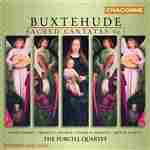
Sacred Cantatas - Volume 2
 $28.00
Out of Stock
$28.00
Out of Stock2-6 weeks add to cart
BUXTEHUDE
Sacred Cantatas - Volume 2
Emma Kirkby (soprano) / Michael Chance (counter-tenor) / Charles Daniels (tenor) / Peter Harvey (bass) / Purcell Quartet
[ Chandos / CD ]
Release Date: Monday 1 August 2005
This item is currently out of stock. We expect to be able to supply it to you within 2 - 6 weeks from when you place your order.
"If Buxtehude cantatas are the object of your enthusiasm, this disc provides a good number of them performed by some of the best early music specialists out there. They are a homogeneous bunch of works, so listening to the disc in one sitting borders on monotony. For a collector, however, this disc should not go unpurchased."
(MusicWeb Nov 2005)
Emma Kirkby, Michael Chance, Charles Daniels, Peter Harvey and The Purcell Quartet perform in this second disc of sacred music by Buxtehude.
The first volume was enthusiastically received.
All the artists here are renowned interpreters of repertoire of this kind.
This is the only available recording for many of the works on the disc.
Buxtehude's legacy, for many centuries neglected, has more recently been re-appraised and its importance accepted, not only for the quality of its craftsmanship but also for its undeniable influence on composers such as J.S. Bach.
The organist of the Marienkirche in Lübeck, Dietrich Buxtehude would often direct a vocal piece during the morning or afternoon service. Small-scale pieces constitute the majority of his vocal output and may have been performed during such services, or outside church, in household devotion or in informal gatherings. At the Swedish court in Stockholm the Kapellmeister, Gustaf Düben, assembled a vast collection of vocal compositions, including much of Buxtehude's output.
The tunefulness and characteristic strophic text setting of the sacred aria, although with several added layers of musical elaboration, can be heard in Nichts soll uns scheiden von der Liebe Gottes. A strophic text is also the basis of Das neugebor'ne Kindelein.The tunefulness of the aria enters An filius non est Dei whose Passiontide atmosphere is evoked with a rich texture of three violas da gamba and continuo, ideal for poignant harmonies. The constant iteration of the bass line characteristic of the ciaccona could create a mesmeric effect, particularly apt in Jesu dulcis memoria in which the onward tread of the walking bass creates continuity across the ends of strophes; the effect is like a ceaseless outpouring of sweetness.
Quemadmodum desiderat cervus also has a ciaccona bass, against which Buxtehude offers a multitude of different figures in the upper voices, ranging from lilting slurs to ecstatic melismas. A related piece is Jesu, komm, mein Trost und Lachen. Cantatas that use passages of Biblical prose set each verse of text to an individually characterised musical phrase, often with instrumental commentary, as in Herr, nun läßt du deinen Diener which concludes with a joyful gigue. A similar gigue is used at the end of Dixit Dominus Domino meo, a setting of Psalm 110. More ambitious is the setting of Psalm 103, verses 1 - 5, Lobe den Herrn, meine Seele. Here the lush key of A major and the opulent string texture of three violins, two violas and continuo all serve to strengthen the exhilaration of praise.
Tracks:
Das neugebor'ne Kindelein, BuxWV 13
Quemadmodum desiderat cervus, BuxWV 92
Nichts soll uns scheiden von der Liebe Gottes, BuxWV 77
Dixit Dominus Domino meo, BuxWV 17
An filius no est Dei, BuxWV 6
Lobe den Herrn, meine Seele, BuxWV 71
Jesu, komm, mein Trost und Lachen, BuxWV 58
Herr, nun läßt du deinen Diener, BuxWV 37
Jesu dulcis memoria, BuxWV 57



